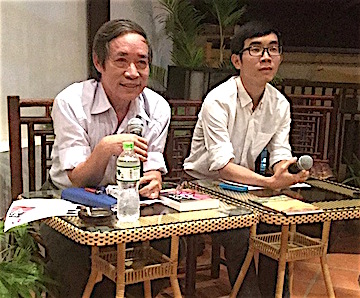By Alison Bate
The corpses filled the river valley, their hands stretched toward the sky.
It was 1979 and Hanoi artist Muoi Trong Nguyen had been sent north to the border with China to record the war scenes for historical purposes. The fighting between China and Vietnam lasted less than a month, but in that short time, more than 30,000 soldiers died in the conflict, also known as the Third Indochina War.
He spent months after the battle ended, sketching and painting watercolors on site, but it’s this image of the hands of the corpses stretched toward the sky that stays with him. Sadly, he says the paintings no longer exist or are in the hands of the military.

Western visitors to Vietnam often focus on the aftermath of the “American War”, as it is known here, or perhaps the colonial period, when France colonized the country. But to most Vietnamese nowadays, these wars are events from the past. Any current fears or threats are focussed on its neighbor China, based on its past invasions, current maritime ambitions and, of course, tempered by a booming trade between the two countries.
Nguyen, who writes in Vietnamese under the name Nguyen Trong Thap*, has brought out a new memoir “Noi Chim” that gives a fascinating glimpse of personal life in north Vietnam during the land reforms, the American War, and his time in the military and as an artist. He read excerpts from “Noi Chim” (Sinking and Swimming) and answered questions at a special reading at Hanoi Cooking Centre in April. At the event “Across the Generations”, he was joined by poet Nguyen Thi Hong Van and blogger and copywriter Yuki Phan, with Thang Tran translating.
He told us that he grew up poor in a farming family in the My Hao district of Hung Yen province, east of Hanoi, the youngest of 10 children. He always wanted to be an artist, but life did not turn out as he planned. At the age of 16, he enrolled in art school in Hanoi but less than six months in, was unceremoniously expelled – caught between a rock and a hard place. In his memoir, he describes how the art school told him he needed to be on the Hanoi resident register to stay, but the district police would grant it only if he handed in the school’s acceptance letter.
“I had to pack up everything and leave, in tears and to the ridicule of friends. Perhaps they would be happy after all, even without my presence. Only I swallowed the pain that would last until my death,” he writes.
“Angry and lonesome, I limped away from class across the school yard, my eyes swollen up, taking a last look at the trees, the chairs, the garden’s statues. I entered the dormitory to pack up. It was empty and quiet. Seeing my dear bed, I flushed away the tears. Everything long gone, no more dreams, no more future and career. Bitter and humiliated.”
Back home in the countryside, he gradually pulled his self-esteem together. Opening his piggy bank, he counted 10 dong and took some to buy paper and art supplies. He began drawing for Lunar New year and for weddings. His father now ran a tailor shop in Hanoi and Nguyen hung his paintings on the wall, in front of the house. Sometimes he drew from dusk to dawn, and his business began to flourish.

But military events punctuated his life. He was only 20 when he joined the North Vietnamese Army in the 1970s. During the American War, Nguyen spent three years in the Truong Son Mountains, working behind the front lines, tasked with ensuring smooth radio communications.
At one time he caught malaria and was lost in the jungle for five days. To cross one particularly heavy river, he blew up a plastic bag and floated across. He eventually emerged in an area where naked female revolutionaries were bathing, he told the audience. They gave him short shrift, furious that he’d invaded their privacy.
Now officially retired, Nguyen still meets with former army colleagues once a year, and his painting work continues. Late last year, he finished two enormous “War and Peace” paintings for a museum in Nghe An province in north Central Vietnam. One shows the peaceful pastoral scene before the American bombing and the other, the wrecked post-war landscape.
* Vietnamese names use the surname first.
[Notes: Muoi Trong Nguyen has been my friend since 2014. Noi Chim was published by Nha Xuat Ban Hoi Nha Van in December 2015]

